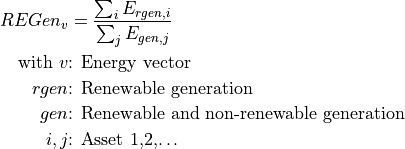Outputs of a simulation¶
After optimization of an energy system, the MVS evaluates the simulation output. It evaluates the flows, costs and performance of the system. As a result, it calculates a number of key performance indicators (KPI), namely economic, technical and environmental KPI. Depending on the simulation settings, it can also generate different output files and figures of the results, including an automatic report in pdf or html format.
Overview of Key Performance Indicators¶
Technical KPI are calculated to assess the performance of a simulated energy system, ie. represent the technical system configuration and operation. They are calculated based on the asset capacities and asset dispatch. They should allow the comparision of different energy system topologies and different project sites with each other. These are the calculated technical KPI:
Economic KPI are calculated to assess the costs of a simulated energy system. They include the costs per asset as well as the system’s overall costs. Relative values like the levelized costs of supply allow a comparision to other investment options. These are the calculated economic KPI:
Environmental KPI are calculated to assess the impact of a simulated energy system on the environment. These are the calculated environmental KPI:
Additionally to the KPI, the MVS can also generate a number of output files, which can be shared with other partners and used to vizualize the system’s behaviour and performance. These are the calculated files KPI:
In the sections economic, technical and environmental KPI, these indicators are further defined and in Files the possible exportable figures and files are presented. This takes place with the following structure:
- Definition
Definition of the defined KPI, can be used as tooltips.
- Type
One of Numeric, Figure, Excel File, JSON, Time series, Logfile or html/pdf
- Unit
Unit of the KPI, multiple units possible if KPI can be applied to individual sectors (see also: Suffixes of KPI).
- Valid Interval
Expected valid range of the KPI. Exceptions are possible under certain conditions.
- Related indicators
List of indicators that are related to the described KPI, either because they are part of its calculation or can be compared to it.
Besides these parameters attributes, the underlying equation of a specific KPI may be presented and explained, or further hints might be provided for the parameter evaluation or for special cases.
Suffixes of KPI¶
The KPI of the MVS can be calculated per asset, for each sector or for the overall system.
KPI calculated per asset are not included in the scalar results of the automatic report or in the stored Excel file, but are displayed separately. They do not need suffixes, as they are always displayed in tables next to the respective asset.
KPI calculated for each vector are specifically these KPI that aggregate the dispatch and costs of multiple assets. For cost-related KPI, such aggregating KPI have the energy vector they are describing as a suffix. An example would be the attributed_costs of each energy vector - the attributed costs of the electricity and H2 sector would be called attributed_costs_electricity and attributed_costs_H2 respectively.
For technical KPI, this suffix also applies, but additionally, due to the energy carrier weighting, they also feature the suffix electricity equivalent when the weighting has been applied. The energy demand of the system is an example: the demand per sector would be total_demand_electricity and total_demand_H2. To be able to aggregate these cost into an overall KPI for the system, the electricity equivalents of both values are calculated. They then are named total_demand_electricity_electricity_equivalent and total_demand_H2_electricity_equivalent.
KPI that describe the costs of the overall energy system do not have suffixes. Technical KPI often have the suffix electricity_equivalent to underline the energy carrier that the parameter is relative to.
Economic KPI¶
All the KPI related to costs described below are provided in net present value.
Net Present Costs (NPC) (costs_total)¶
- Definition
Net present costs of the system for the whole project duration, includes all operation, maintainance and dispatch costs as well as the investment costs (including replacements). Applied to a single asset, the costs can also be called present costs of the asset.
- Type
Numeric
- Unit
currency
- Valid Interval
>=0
- Related indicators
Operation and maintenance costs (costs_cost_om) | Dispatch costs (costs_dispatch) | Investment costs (costs_investment_over_lifetime) | Operation, maintenance and dispatch costs (costs_om_total) | Upfront investment costs (costs_upfront_in_year_zero)
The Net present costs (NPC) is the present value of all the costs associated with installation, operation, maintenance and replacement of energy assets within the optimized multi-vector energy system over the whole project lifetime, deducting the present value of the residual value of asset at project end and as well as all the revenues that it earns over the project lifetime. The capital recovery factor (CRF) is used to calculate the present value of the cash flows.

Operation and maintenance costs (costs_cost_om)¶
- Definition
Costs for fix annual operation and maintenance costs over the whole project lifetime, which do not depend on the assets dispatch but solely on installed capacity. An example would be the maintenance costs for cleaning the installed PV capacity.
- Type
Numeric
- Unit
currency
- Valid Interval
>=0
- Related indicators
Dispatch costs (costs_dispatch) | Investment costs (costs_investment_over_lifetime) | Operation, maintenance and dispatch costs (costs_om_total) | Net Present Costs (NPC) (costs_total) | Upfront investment costs (costs_upfront_in_year_zero)
Operation, maintenance and dispatch costs (costs_om_total)¶
- Definition
Costs for annual operation and maintenance costs as well as dispatch of all assets of the energy system, for the whole project duration.
- Type
Numeric
- Unit
currency
- Valid Interval
>=0
- Related indicators
Operation and maintenance costs (costs_cost_om) | Dispatch costs (costs_dispatch) | Investment costs (costs_investment_over_lifetime) | Net Present Costs (NPC) (costs_total) | Upfront investment costs (costs_upfront_in_year_zero)
Dispatch costs (costs_dispatch)¶
- Definition
Dispatch costs over the whole project lifetime including all expenditures that depend on the dispatch of assets (e.g. fuel costs, electricity consumption from the external grid, costs for operation and maintainance that depend on the throughput of an asset)
- Type
Numeric
- Unit
currency
- Valid Interval
>=0
- Related indicators
Operation and maintenance costs (costs_cost_om) | Investment costs (costs_investment_over_lifetime) | Operation, maintenance and dispatch costs (costs_om_total) | Net Present Costs (NPC) (costs_total) | Upfront investment costs (costs_upfront_in_year_zero)
Investment costs (costs_investment_over_lifetime)¶
- Definition
Investment costs over the whole project lifetime, including all replacement costs.
- Type
Numeric
- Unit
currency
- Valid Interval
>=0
- Related indicators
Operation and maintenance costs (costs_cost_om) | Dispatch costs (costs_dispatch) | Operation, maintenance and dispatch costs (costs_om_total) | Net Present Costs (NPC) (costs_total) | Upfront investment costs (costs_upfront_in_year_zero) | Replacement costs (replacement_costs_during_project_lifetime)
Upfront investment costs (costs_upfront_in_year_zero)¶
- Definition
The costs which will have to be paid upfront when project begins, ie. In year 0. These are the investment and fix project costs into the chosen configuration.
- Type
Numeric
- Unit
currency
- Valid Interval
>=0
- Related indicators
Operation and maintenance costs (costs_cost_om) | Dispatch costs (costs_dispatch) | Investment costs (costs_investment_over_lifetime) | Operation, maintenance and dispatch costs (costs_om_total) | Net Present Costs (NPC) (costs_total)
Replacement costs (replacement_costs_during_project_lifetime)¶
- Definition
Costs for replacement of assets which occur over the project lifetime.
- Type
Numeric
- Unit
currency
- Valid Interval
>=0
- Related indicators
Costs attributed to a specific sector (attributed_costs)¶
- Definition
Costs attributed to supplying the demand of a specific sector, based on the net present costs (NPC) of the energy system and the share of the sector demand compared to the overall system demand.
- Type
Numeric
- Unit
currency
- Valid Interval
>=0
- Related indicators
A multi-vector energy system connects energy vectors into a joined energy system and the system is then designed to have an optimial, joined operation. With other systems, the costs associated to each individual energy vector would be used to calculate the costs to supply the individual sector. With the multi-vector system, this could lead to distorted costs - for example if there is a lot of PV (electricity sector), which in the end is only supplying an electrolyzer (H2 sector). The investment and operational costs of the electricity sector assets would thus turn out to be very high, which could be considered unfair as the electricity from PV is solely used to provide the H2 demand. Therefore, we define the attributed costs of each energy vector, to determine how much of the overall system costs should be attributed to one sector, depending on the energy demand it has compared to the other sectors. To be able to compare the demands of different energy carriers, energy carrier weighting is applied.
Annuity (annuity_total)¶
- Definition
Annuity of the assets costs over the project lifetime or the energy system’s net present costs (NPC) .
- Type
Numeric
- Unit
currency/a
- Valid Interval
>=0
- Related indicators
Annual operation, maintenance and dispatch expenses (annuity_om) | Net Present Costs (NPC) (costs_total)
Annual operation, maintenance and dispatch expenses (annuity_om)¶
- Definition
Annuity of the operation, maintenance and dispatch costs of the asset or energy system, i.e. ballpark number of the annual expenses for asset or system operation.
- Type
Numeric
- Unit
currency/a
- Valid Interval
>=0
- Related indicators
Annuity (annuity_total) | Operation, maintenance and dispatch costs (costs_om_total)
Levelized costs of electricity equivalent (levelized_costs_of_electricity_equivalent)¶
- Definition
Levelized cost of energy of the sector-coupled energy system, calculated from the systems annuity and the total system demand in electricity equivalent.
- Type
Numeric
- Unit
currency/kWheleq
- Valid Interval
>=0
- Related indicators
Net Present Costs (NPC) (costs_total) | Energy demand (total_demand)
Specific electricity supply costs, eg. levelized costs of electricity are commonly used to compare the supply costs of different investment decisions or also energy provider prices to local generation costs. However, the a multi-vector energy system connects energy vectors into a joined energy system and the optimization objective of the MVS then is to minimize the overall energy costs, without distinguising between the different sectors. This sector-coupled energy system is then designed to have an optimial, joined operation. With other systems, the costs associated to each individual energy vector would be used to calculate the levelized costs of energy (LCOEnergy). With the multi-vector system, this could lead to distorted costs - for example if there is a lot of PV (electricity sector), which in the end is only supplying an electrolyzer (H2 sector). The LCOE of electricity would thus turn out to be very high, which could be considered unfair as the electricity from PV is solely used to provide the H2 demand. Therefore, we define the attributed costs of each energy vector, to determine how much of the overall system costs should be attributed to one sector, depending on the energy demand it has compared to the other sectors. To be able to compare the demands of different energy carriers, energy carrier weighting is applied.
Therefore the levelized costs of energy (LCOEnergy) for energy carrier  are defined based on the annuity of the attributed costs, the CRF and the demand of one energy sector
are defined based on the annuity of the attributed costs, the CRF and the demand of one energy sector  :
:

The LCOEnergy are are calculated for each sector (resulting in the levelized costs of electricity, heat, H2…), but also for the overall energy system. For the overall energy system, the levelized costs of electricity equivalent are calculated, as this system may supply different energy vectors.
Levelized cost of throughput (levelized_cost_of_energy_of_asset)¶
- Definition
Cost per kWh throughput through an asset, based on the assets costs during the project lifetime as well as the total throughput through the asset in the project lifetime. For generation assets, equivalent to the levelized cost of generation.
- Type
Numeric
- Unit
currency/kWh
- Valid Interval
>=0
- Related indicators
Annuity (annuity_total) | Aggregated flow (annual_total_flow)
This KPI measures the cost of generating 1 kWh for each asset in the system.
It can be used to assess and compare the available alternative methods of energy production.
The levelized cost of energy of an asset ( ) is usually obtained
by looking at the lifetime costs of building and operating the asset per unit of total energy throughput of an asset over the assumed lifetime [currency/kWh].
) is usually obtained
by looking at the lifetime costs of building and operating the asset per unit of total energy throughput of an asset over the assumed lifetime [currency/kWh].
Since not all assets are production assets, the MVS distinguishes between the type of assets.
For assets in energyConversion and energyProduction the MVS calculates the  by dividing the total annuity
by dividing the total annuity  of the asset
of the asset  by the total flow
by the total flow  .
.

For assets in energyStorage, the MVS sums the annuity for storage capacity  ,
, input power  and
and output power  and divides it by the
and divides it by the output power total flow  .
.

If the total flow is 0 in any of the previous cases, then the  is set to
is set to None.

For assets in energyConsumption, the MVS outputs 0 for the  .
.

Technical KPI¶
Optimal additional capacity (optimizedAddCap)¶
- Definition
Capacity added to installed capacity for optimal economic system performance.
- Type
Numeric
- Unit
kW, kWh, kWp, …
- Valid Interval
>=0
- Related indicators
Dispatch of an asset (flow)¶
- Definition
Optimized dispatch of an asset in the optimized energy system, ie. its generation or thoughput.
- Type
Time series (with time stamps and values)
- Unit
kW,kgH2,…
- Valid Interval
NA
- Related indicators
Dispatch of all assets on a bus | Peak flow (peak_flow) | Aggregated flow (annual_total_flow) | Average flow (average_flow)
Peak flow (peak_flow)¶
- Definition
Peak of the dispatch of an asset.
- Type
Numeric
- Unit
kW
- Valid Interval
>=0
- Related indicators
Average flow (average_flow) | Aggregated flow (annual_total_flow)
Average flow (average_flow)¶
- Definition
Average value of the assets dispatch. The ratio of average dispatch to peak dispatch indicates how much the asset is used in comparison to its actual installed capacity.
- Type
Numeric
- Unit
kWh
- Valid Interval
>=0
- Related indicators
Aggregated flow (annual_total_flow)¶
- Definition
Dispatch of the asset over a year, aggregated generation, demand or throughput.
- Type
Numeric
- Unit
kWh
- Valid Interval
>=0
- Related indicators
Energy demand (total_demand)¶
- Definition
Demand of energy in local energy system over a the project lifetime.
- Type
Numeric
- Unit
kWh, kWheleq, …
- Valid Interval
>=0
- Related indicators
None
Energy export (total_feedin)¶
- Definition
Feed-in of energy into external grid.
- Type
Numeric
- Unit
kWh, kWheleq, …
- Valid Interval
>=0
- Related indicators
Energy import (total_consumption_from_energy_provider)¶
- Definition
Aggregated energy imports into the local energy system from the provider.
- Type
Numeric
- Unit
kWh, kWheleq, …
- Valid Interval
>=0
- Related indicators
None
Total non-renewable local generation (total_internal_non-renewable_generation)¶
- Definition
Aggregated amount of non-renewable energy generated within the energy system.
- Type
Numeric
- Unit
kWheleq
- Valid Interval
>=0
- Related indicators
Total local generation (total_internal_generation) | Total renewable local generation (total_internal_renewable_generation)
Total renewable local generation (total_internal_renewable_generation)¶
- Definition
Aggregated amount of renewable energy generated within the energy system.
- Type
Numeric
- Unit
kWheleq
- Valid Interval
>=0
- Related indicators
Total local generation (total_internal_generation) | Total non-renewable local generation (total_internal_non-renewable_generation)
Total local generation (total_internal_generation)¶
- Definition
Aggregated amount of energy generated within the energy system.
- Type
Numeric
- Unit
kWheleq
- Valid Interval
>=0
- Related indicators
Total non-renewable local generation (total_internal_non-renewable_generation) | Total renewable local generation (total_internal_renewable_generation)
Energy excess (total_excess)¶
- Definition
Excess of energy, ie. unused energy in local energy system.
- Type
Numeric
- Unit
kWh, kWheleq, …
- Valid Interval
>=0
- Related indicators
None
Total renewable energy use (total_renewable_energy_use)¶
- Definition
Aggregated amount of renewable energy used within the energy system (ie. Including local generation and external supply).
- Type
Numeric
- Unit
kWheleq
- Valid Interval
>=0
- Related indicators
Total non-renewable energy use (total_non-renewable_energy_use)
Total non-renewable energy use (total_non-renewable_energy_use)¶
- Definition
Aggregated amount of non-renewable energy used within the energy system (ie. Including local generation and external supply).
- Type
Numeric
- Unit
kWheleq
- Valid Interval
>=0
- Related indicators
Renewable factor (renewable_factor)¶
- Definition
Describes the share of the energy influx to the local energy system that is provided from renewable sources. This includes both local generation as well as consumption from energy providers.
- Type
Numeric
- Unit
Factor
- Valid Interval
[0,1]
- Related indicators
Renewable share of local generation (renewable_share_of_local_generation) | Onsite energy fraction (onsite_energy_fraction) | Onsite energy matching (onsite_energy_matching)
Describes the share of the energy influx to the local energy system that is provided from renewable sources. This includes both local generation as well as consumption from energy providers.
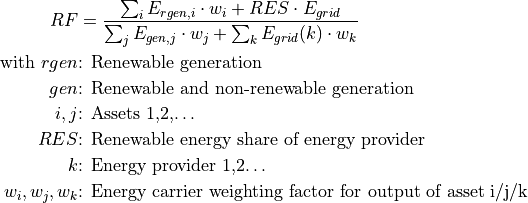
- Example
An energy system is composed of a heat and an electricity side. Following are the energy flows:
100 kWh from a local PV plant
0 kWh local generation for the heat side
100 kWh consumption from the electricity provider, who has a renewable factor of 50%
Again, the heat sector would have a renewable factor of 0% when considered separately, and the electricity side would have an renewable factor of 75%. This results in a system-wide renewable share of:

The renewable factor, just like the Renewable share of local generation (renewable_share_of_local_generation), cannot indicate how much renewable energy is used in each of the sectors. In the future, it might be possible to get a clearer picture of the flows between the sectors with the proposed degree of sector-coupling.
Degree of sector-coupling (DSC)¶
To assess how much an optimized multi-vector energy system makes use of the potential of sector-coupling, it is planned to introduce the degree of sector-coupling in the future. This level of interconnection is to be calculated with the ratio of energy flows in between the sectors (ie. those, where energy carriers are converted to another energy carrier) to the energy demand supplied:

Note
This feature is currently not implemented.
Onsite energy fraction (onsite_energy_fraction)¶
- Definition
Onsite energy fraction is also referred to as self-consumption. It describes the fraction of all locally generated energy that is consumed by the system itself.
- Type
Numeric
- Unit
Factor
- Valid Interval
[0,1]
- Related indicators
Onsite energy fraction is also referred to as “self-consumption”. It describes the fraction of all locally generated energy that is consumed by the system itself. (see [1] and [2]).
An OEF close to zero shows that only a very small amount of locally generated energy is consumed by the system itself. It is at the same time an indicator that a large amount is fed into the grid instead. A OEF close to one shows that almost all locally produced energy is consumed by the system itself.
![OEF &=\frac{\sum_{i} {(E_{generation} (i) - E_{gridfeedin}(i)) \cdot w_i}}{\sum_{i} {E_{generation} (i) \cdot w_i}}
&OEF \epsilon \text{[0,1]}](../_images/math/1d75e60f1a338d5626fdb7fd743638b4a60b906c.png)
Onsite energy matching (onsite_energy_matching)¶
- Definition
The onsite energy matching is also referred to as self-sufficiency. It describes the fraction of the total demand that can be covered by the locally generated energy.
- Type
Numeric
- Unit
Factor
- Valid Interval
[0,1]
- Related indicators
Onsite energy fraction (onsite_energy_fraction) | Energy export (total_feedin)
The onsite energy matching is also referred to as “self-sufficiency”. It describes the fraction of the total demand that can be covered by the locally generated energy (see [1] and [2]).
An OEM close to zero shows that very little of the demand can be covered by locally produced energy. Am OEM close to one shows that almost all of the demand can be covered with locally generated energy. Per definition OEM cannot be greater than 1 because the excess generated energy would automatically be fed into the grid or an excess sink.
![OEM &=\frac{\sum_{i} {(E_{generation} (i) - E_{gridfeedin}(i) - E_{excess}(i)) \cdot w_i}}{\sum_i {E_{demand} (i) \cdot w_i}}
&OEM \epsilon \text{[0,1]}](../_images/math/4daa6bdf09855555b9176cd6f8fa29db1b5cd129.png)
Note
The feed into the grid should only be positive.
Degree of Autonomy (degree_of_autonomy)¶
- Definition
A degree of autonomy close to zero shows high dependence on the energy provider, while a degree of autonomy of 1 represents an autonomous or net-energy system and a degree of autonomy higher 1 a surplus-energy system.
- Type
Numeric
- Unit
Factor
- Valid Interval
[0,1]
- Related indicators
The degree of autonomy describes the overall energy consumed minus the energy consumed from the grid divided by the overall energy consumed. Adapted from this definition [3].
A degree of autonomy close to zero shows high dependence on the grid operator, while a degree of autonomy of one represents an autonomous system. Note that this key parameter indicator does not take into account the outflow from the system to the grid operator (also called feedin). As above, we apply a weighting based on Electricity Equivalent.

Degree of Net Zero Energy (degree_of_nze)¶
- Definition
The degree of net zero energy describes the ability of an energy system to provide its aggregated annual demand through local sources.
- Type
Numeric
- Unit
Factor
- Valid Interval
>=0
- Related indicators
Energy export (total_feedin) | Energy import (total_consumption_from_energy_provider)
The degree of net zero energy describes the ability of an energy system to provide its aggregated annual demand though local sources. For that, the balance between local generation as well as consumption from and feed-in towards the energy provider is compared. In a net zero energy system, demand can be supplied by energy import, but then local energy generation must provide an equally high energy export of energy in the course of the year. In a plus energy system, the export exceeds the import, while local generation can supply all demand (from an aggregated perspective). To calculate the degree of NZE, the margin between grid feed-in and grid consumption is compared to the overall demand.
Some definitions of NZE systems require that the local demand is solely covered by locally generated renewable energy. In MVS this is not the case - all locally generated energy is taken into consideration. For information about the share of renewables in the local energy system checkout Renewable share of local generation (renewable_share_of_local_generation).
A degree of NZE lower than 1 shows that the energy system can not reach a net zero balance, and indicates by how much it fails to do so, while a degree of NZE of 1 represents a net zero energy system and a degree of NZE higher 1 a plus-energy system.
As above, we apply a weighting based on Electricity Equivalent.

Environmental KPI¶
Total GHG emissions (total_emissions)¶
- Definition
Total greenhouse gas emissions in kg.
- Type
Numeric
- Unit
kg GHGeq
- Valid Interval
>=0
- Related indicators
Renewable factor (renewable_factor) | Specific GHG per electricity equivalent (specific_emissions_per_electricity_equivalent)
The total emissions of the MES in question are calculated with all aggregated energy flows from the generation assets including energy providers and their subsequent emission factor:

The emissions of each generation asset and provider are also calculated and displayed separately in the outputs of MVS.
Specific GHG per electricity equivalent (specific_emissions_per_electricity_equivalent)¶
- Definition
Specific GHG emissions per supplied electricity equivalent.
- Type
Numeric
- Unit
kg GHGeq/kWh
- Valid Interval
>=0
- Related indicators
The specific emissions per electricity equivalent of the MES are calculated in  :
:

Emissions can be of different nature: CO2 emissions, CO2 equivalents, greenhouse gases, …
Currently the emissions do not include life cycle emissions of energy conversion or storage assets, nor are they calculated separately for the energy sectors. For the latter, the problem of the assignment of assets to sectors arises e.g. emissions caused by an electrolyser would be counted to the electricity sector although you might want to count it for the H2 sector, as the purpose of the electrolyser is to feed the H2 sector. Therefore, we will have to verify whether or not we can apply the energy carrier weighting also for this KPI.
Files¶
Bar chart of optimal capacities¶
- Definition
A bar chart to compare the optimized additional capacities for each asset to be installed in the energy system. Please be aware that the units of the capacities may different.
- Type
Figure
- Unit
kWh, kWp, kW, …
- Valid Interval
NA
- Related indicators
An example of a bar chart of recommended additional asset capacities is shown below. Note that currently kWp are displayed on the same scale as kW (or kWh or gkH2), which is not ideal.
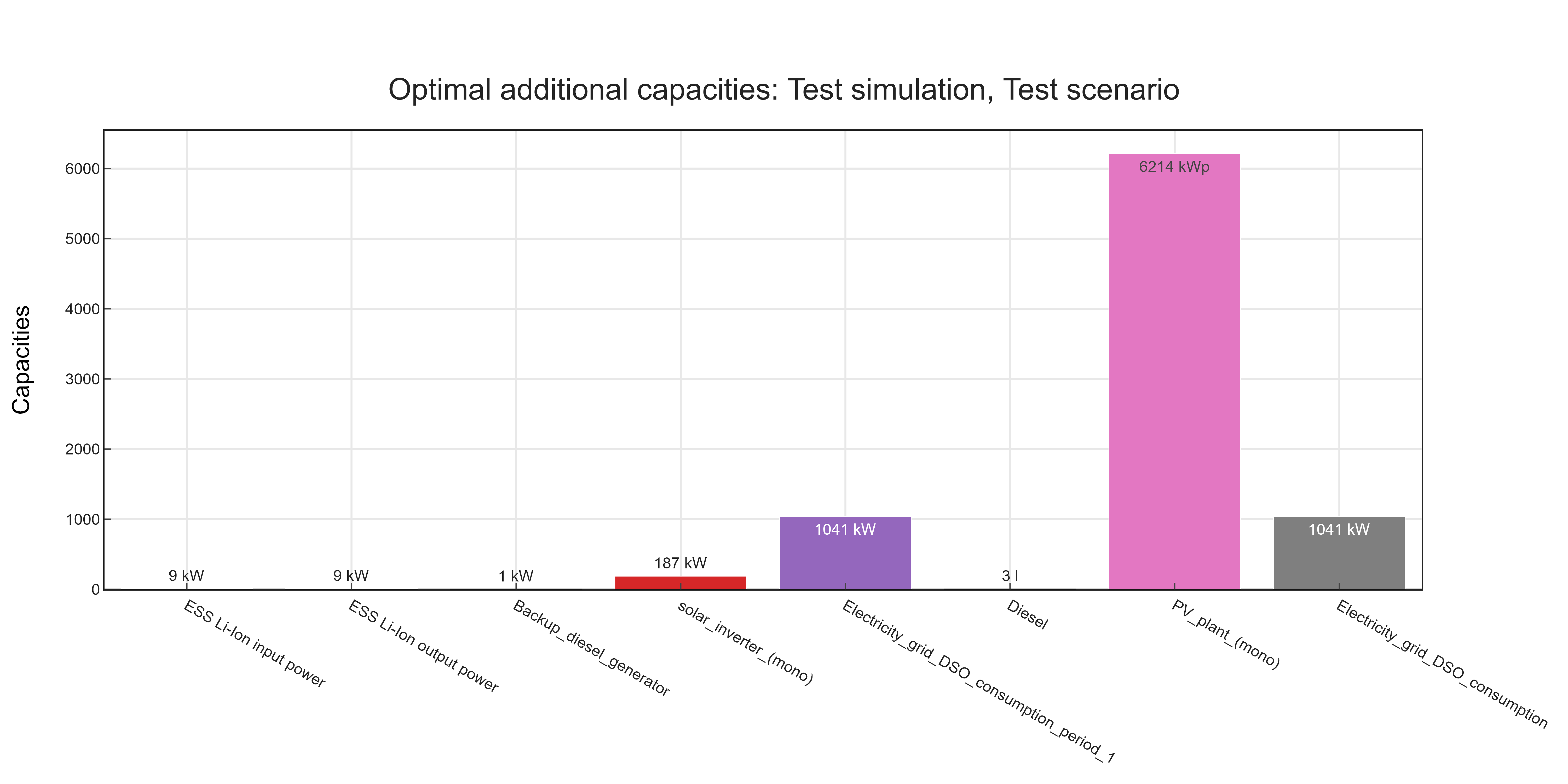
Pie charts of cost parameters¶
- Definition
Displays the share of individual asset costs on different economical parameters of the overall system
- Type
Figure
- Unit
Percentages
- Valid Interval
NA
- Related indicators
Net Present Costs (NPC) (costs_total) | Operation, maintenance and dispatch costs (costs_om_total) | Annuity (annuity_total)
An examplary pie chart is displayed below, in this case for the operation and management costs of an energy system.
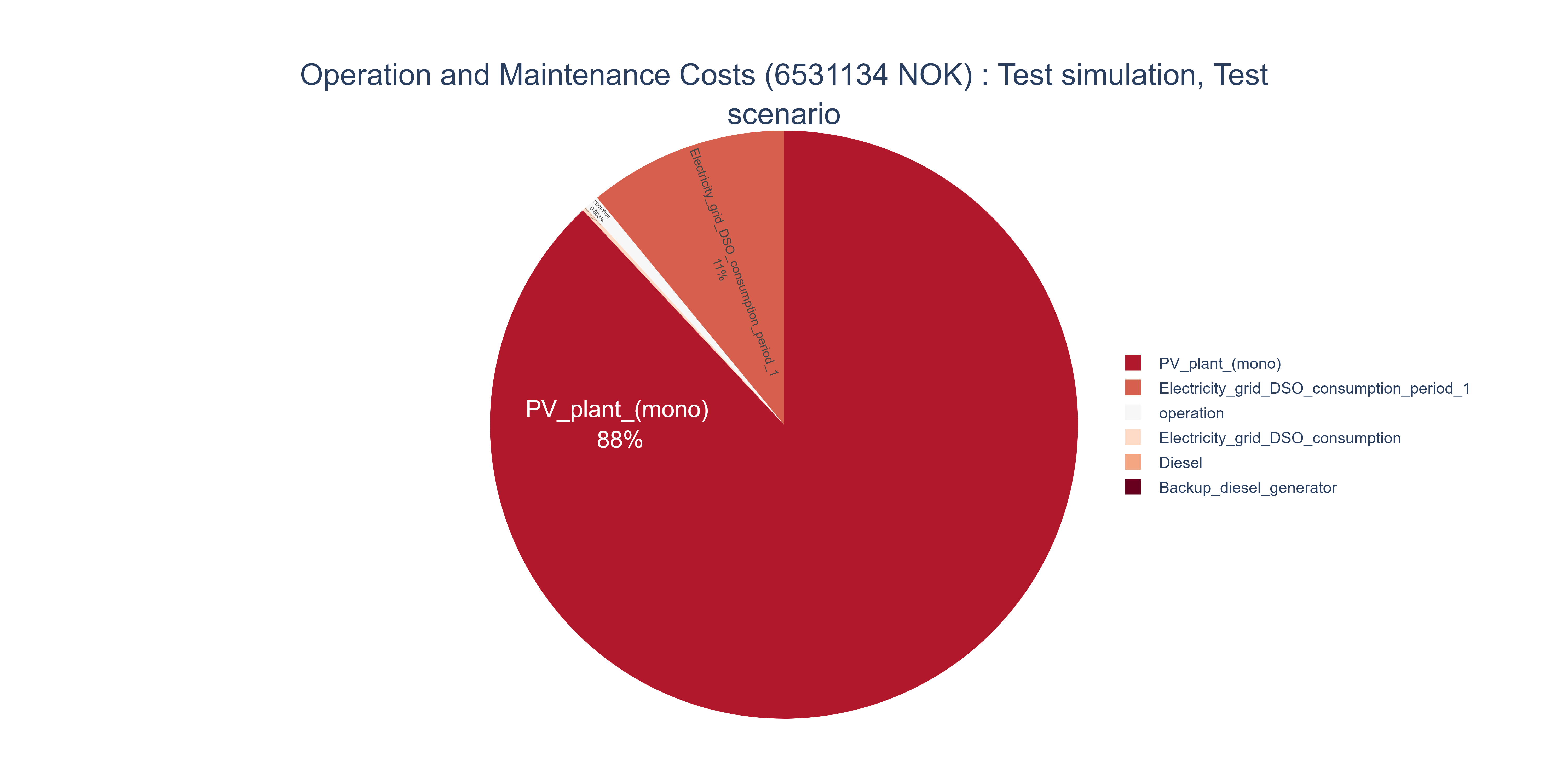
Input timeseries¶
- Definition
Vizualization of timeseries provided as input data, eg. PV generation timeseries.
- Type
Figure
- Unit
kW, kgH2, …
- Valid Interval
NA
- Related indicators
None
An example of the graph created from the timeseries, eg. specific generation timeseries, provided by the input files is shown below.
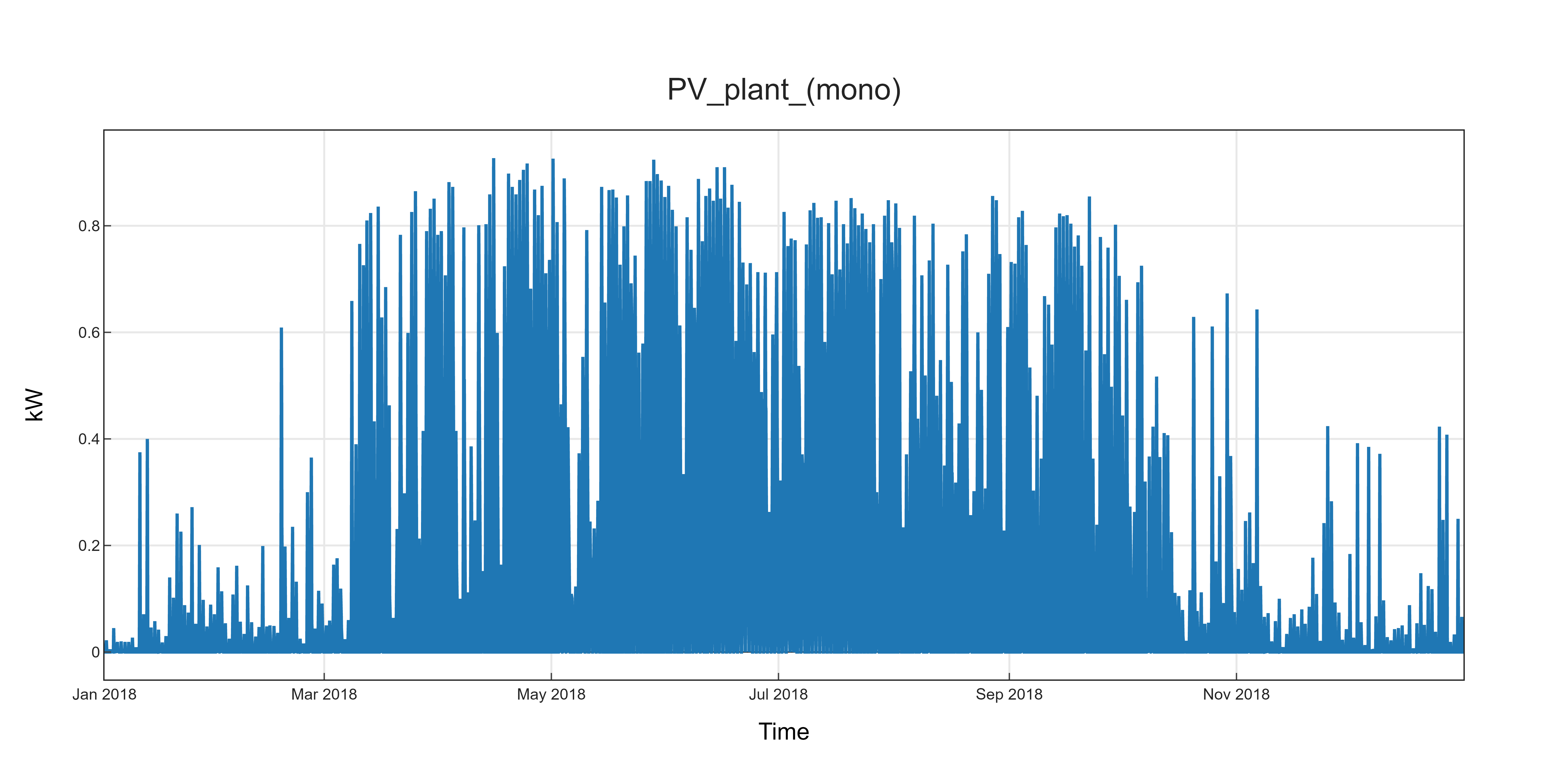
Dispatch of all assets on a bus¶
- Definition
Visualization of the dispatch of all assets of a specific energy bus, ie. all inflows and outflows of a specific bus. Generated for every single energy bus in the energy system. If relevant, a plot of the state of charge is also displayed.
- Type
Figure
- Unit
kW, kgH2, …
- Valid Interval
NA
- Related indicators
An example of the graph displaying the asset dispatch on a specific bus is shown below.
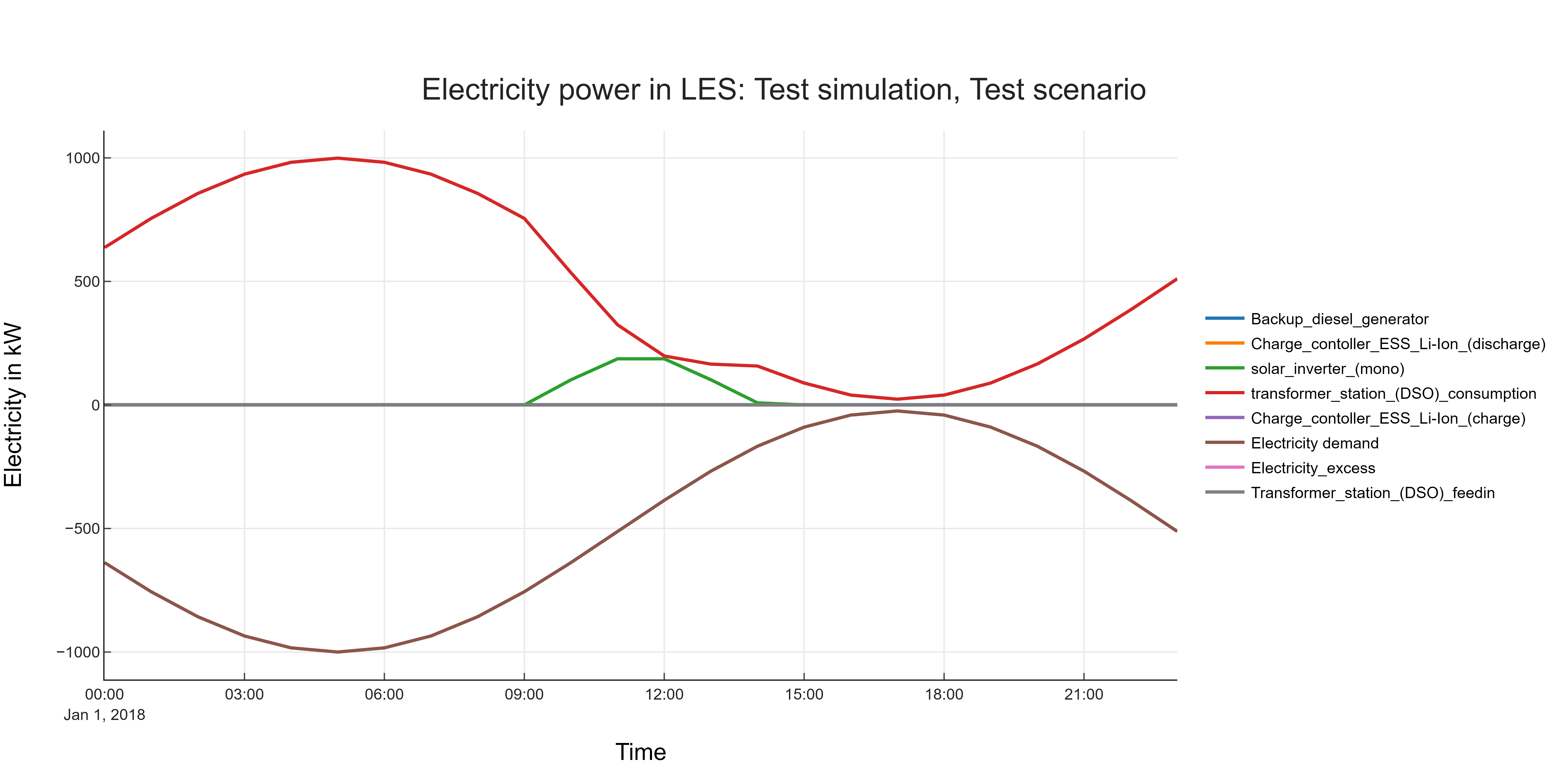
Energy system model visualization¶
- Definition
Plot of the energy system model in oemof-solph topology. This graph also includes the automatically generated components, ie. the sub-assets of energy providers and an energy excess sink on each energy bus. The model therefore appears different than in the Energy Planning Application (EPA).
- Type
Figure
- Unit
NA
- Valid Interval
NA
- Related indicators
None
An example of the created energy system model graphs is shown below.
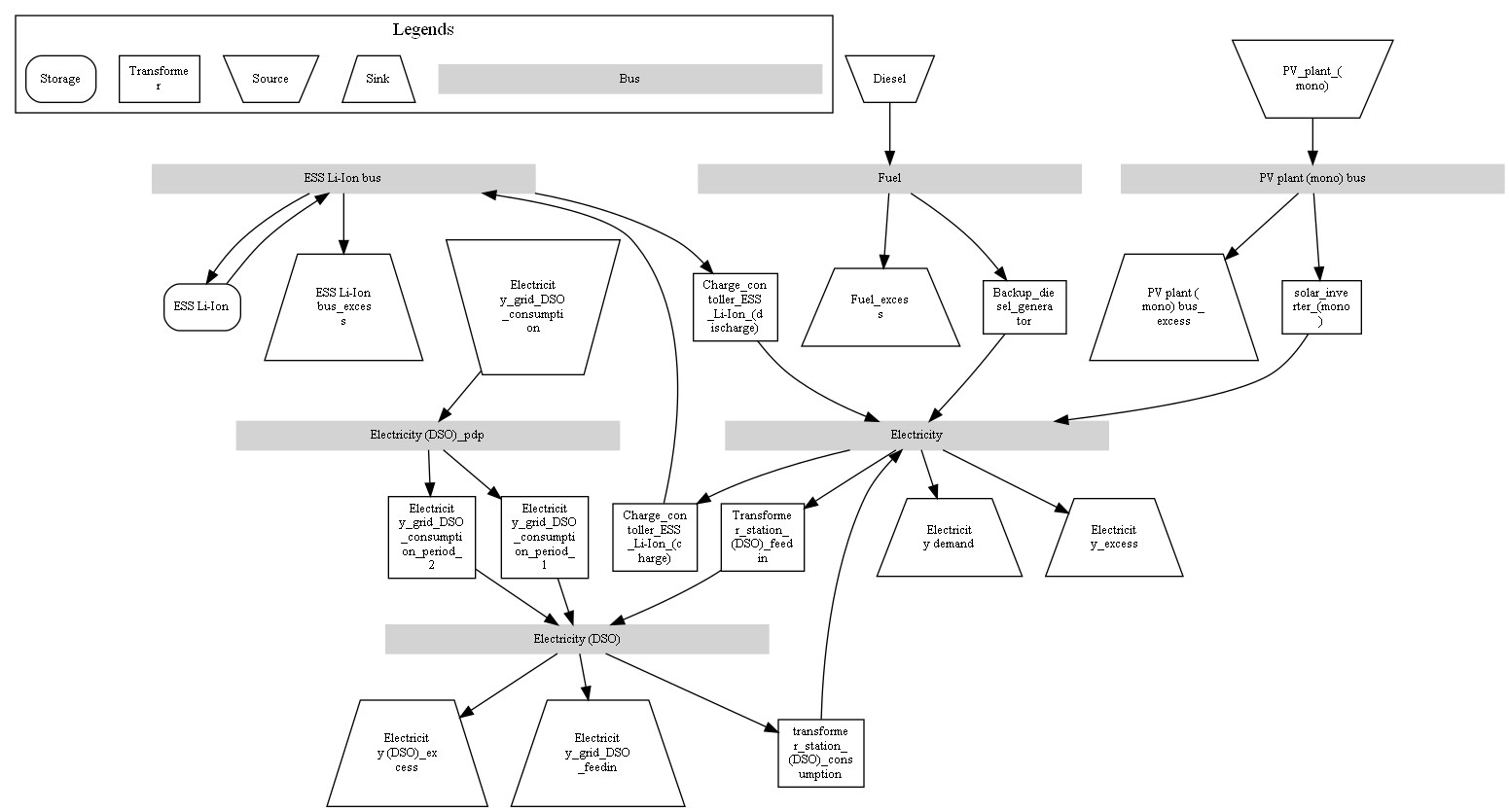
Excel file with all KPI¶
- Definition
Excel sheet with all calculated KPI, both for the individual assets, the sectors and the overall energy system.
- Type
Excel file
- Unit
NA
- Valid Interval
NA
- Related indicators
None
The file is named scalars.xlsx. An example is shown below.
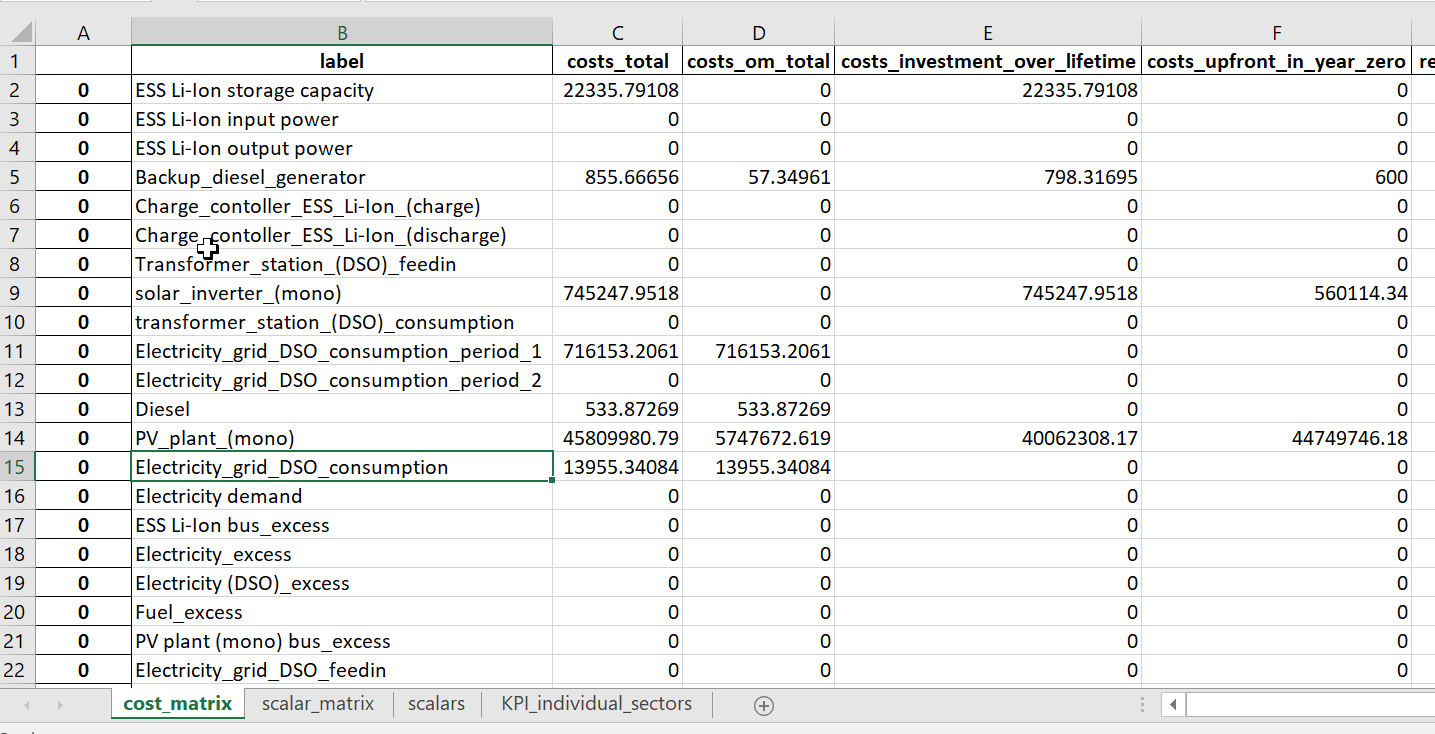
Excel file with dispatch timeseries¶
- Definition
Excel sheet with the dispatch of all assets of the energy system. Each tab represents one energy bus.
- Type
Excel file
- Unit
NA
- Valid Interval
NA
- Related indicators
Dispatch of an asset (flow) | Dispatch of all assets on a bus
The file is named timeseries_all_busses.xlsx. An example is shown below.
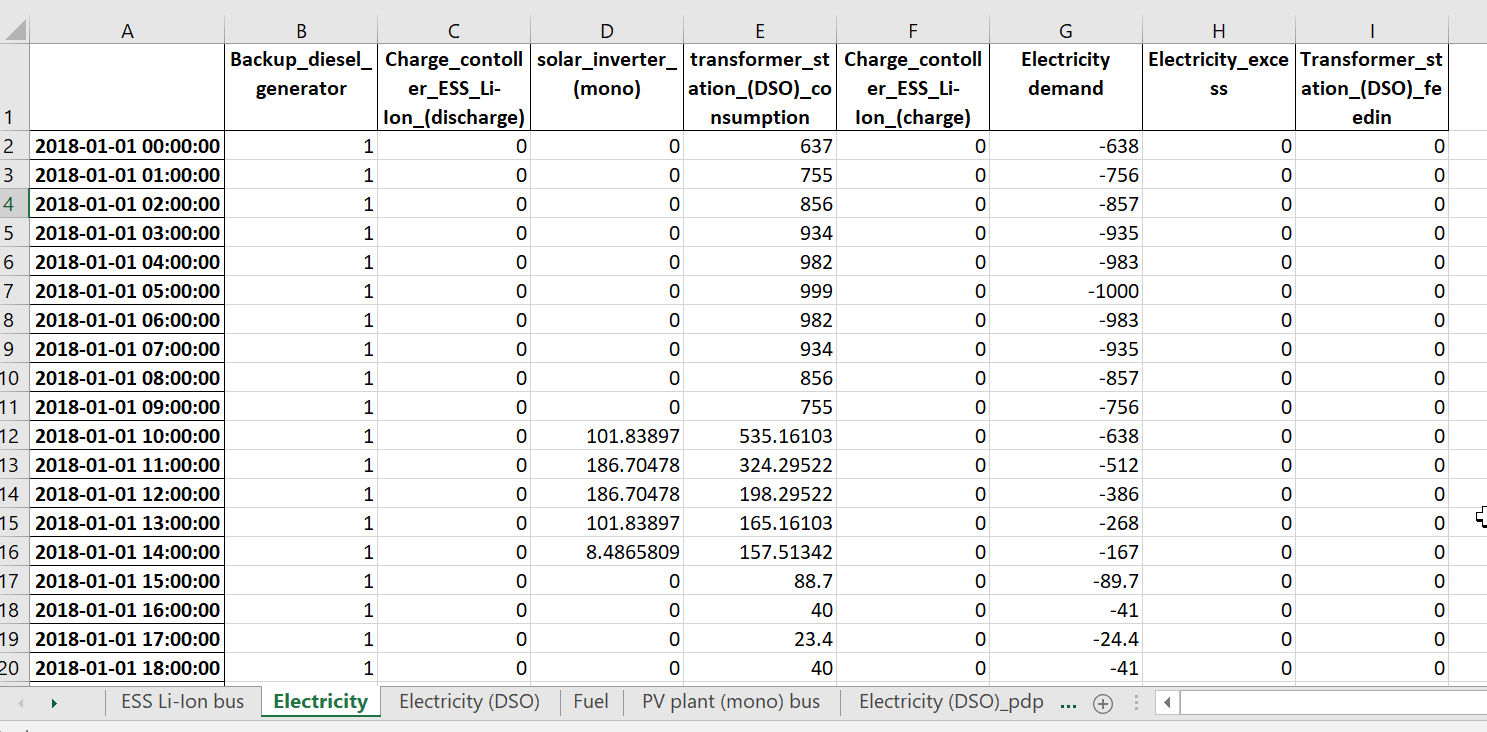
MVS logfile¶
- Definition
Logfile of the MVS simulation including a number of log entries: Debug, information, warning and error messages. Helpful to debug the energy system simulation.
- Type
Logfile
- Unit
NA
- Valid Interval
NA
- Related indicators
None
The file is named mvs_logfile.log. An example is shown below.
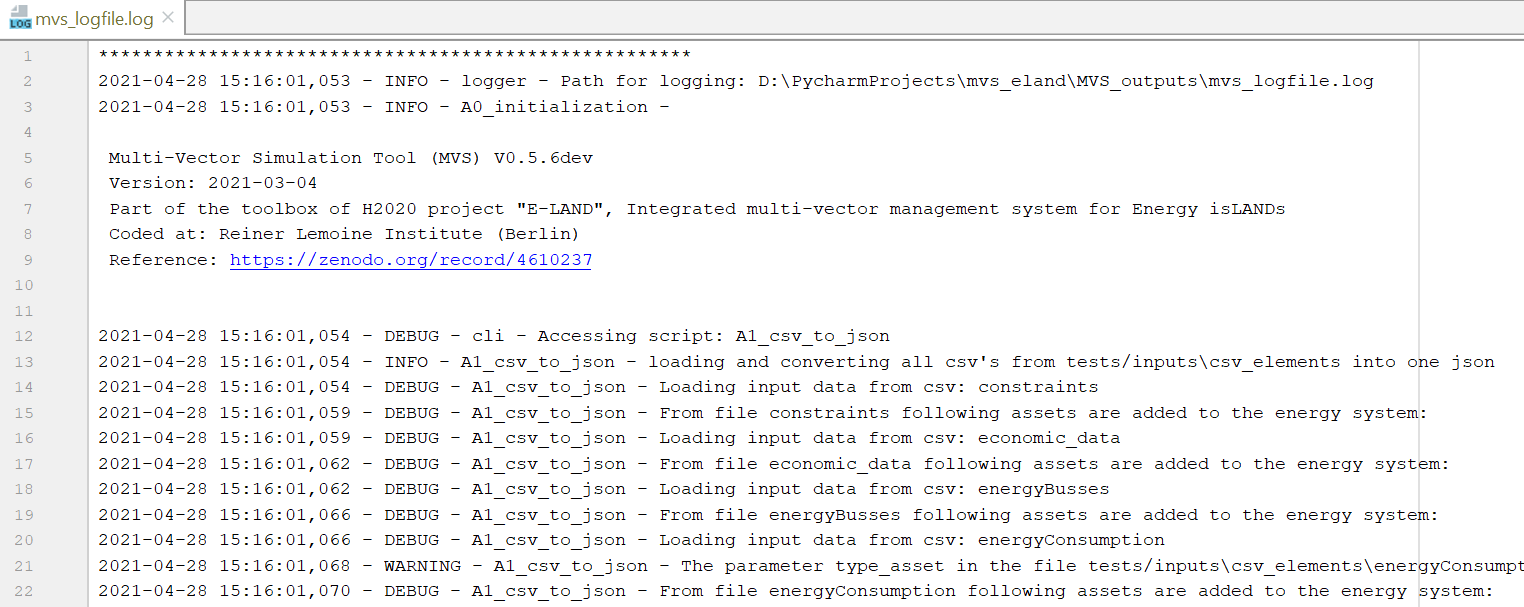
Simulation report¶
- Definition
Automatically generated simulation report, including the most important input data as well as all output data. The html can be browsed interactively, while the pdf can be shared with partners.
- Type
html or pdf
- Unit
NA
- Valid Interval
NA
- Related indicators
None
MVS has a feature to automatically generate a PDF report that contains the main elements from the input data as well as the simulation results’ data. The report can also be viewed as a web app on the browser, which provides some interactivity.
MVS version number, the branch ID and the simulation date are provided as well in the report, under the MVS logo. A commit hash number is provided at the end of the report in order to prevent the erroneous comparing results from simulations using different versions.
It includes several tables with project data, simulation settings, the various demands supplied by the user, the various components of the system and the optimization results such as the energy flows and the costs. The report also provides several plots which help to visualize the flows and costs.
Please, refer to the report section for more information on how to setup and use this feature, or type
mvs_report -h
in your terminal or command line.
A screenshot of the example report header is displayed below. The full examplary report can be accessed on github in docs/model/images/example_simulation_report.pdf.

Simulation data after pre-processing (JSON)¶
- Definition
This file includes all data that is used to setup the energy system model, including all the pre-processing performed within the module C0. It is mostly used by developers.
- Type
JSON
- Unit
NA
- Valid Interval
NA
- Related indicators
None
Simulation data and results (JSON)¶
- Definition
This file includes all simulation data and also results of the energy system optimization. With
mvs_reportthis file can be used to create a report without re-simulating the energy system. This file is also only used by developers, and also the file used to provide the EPA with the simulation results.- Type
JSON
- Unit
NA
- Valid Interval
NA
- Related indicators
None
